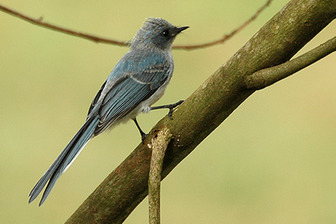White-tailed Blue Flycatcher
Its natural habitats are subtropical or tropical dry forests, subtropical or tropical moist lowland forests, and dry savanna.

Original source: Tom TarrantPermission(Reusing this file)Attribution ShareAlike 3.0
Author: Tom TarrantPermission(Reusing this file)Attribution ShareAlike 3.0
The White-tailed Blue Flycatcher is classified as Least Concern. Does not qualify for a more at risk category. Widespread and abundant taxa are included in this category.
white-tailed blue flycatcher, great blue turaco, barred long-tailed cuckoo and white-bellied crested flycatcher. At night, Rwenzori nightjar is not uncommon, Albertine owlet may be found, and there might be a possibility to see the Congo bay-owl. Add to this the presence of 13 primates, including chimpanzee, more than 100 different butterflies and over 125 varieties of wild orchids and this should be a site on any birders must-visit list. More
White-tailed Blue Flycatcher, Eastern Mountain Greenbul, Chestnut-throated Apalis, White-browed Crombec and a particularly confiding Black-headed Waxbill. Lagden’s Bush-Shrike called from nearby, but refused to show itself. After dark Ruwenzori Nightjar sang incessantly from the valley below us, but refused to come any closer for a view. Our final day was spent walking down to Mabwindi Swamp, a tough but very rewarding trail passing over a series of ridges before dropping steadily to a large upland swamp. More
Family : Monarchidae
Genus : Elminia
Species : albicauda
Authority : Barboza du Bocage, 1877
